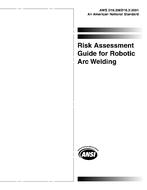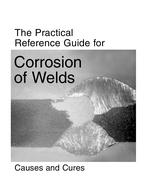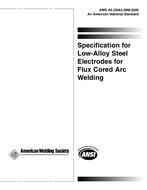Click here to purchase
AWS D1.5M/D1.5:2015 covers the welding requirements for AASHTO welded highway bridges made from carbon and low-alloy constructional steels. This 2015 edition contains dimensions in metric SI Units and U.S. Customary Units. Clauses 1 through 7 constitute a body of rules for the regulation of welding in steel construction. The provisions for Clause 9 have been distributed throughout the D1.5 code. Clauses 8, 10, and 11 do not contain provisions, as their analogue D1.1 sections are not applicable to the D1.5 code. Clause 12 contains the requirements for fabricating fracture critical members.
1.1 Application1.1.1 This code covers welding fabrication requirements applicable to welded highway bridges. The code is applicable to both shop and field fabrication of steel bridges and bridge components. The code is to be used in conjunction with the AASHTO Standard Specification for Highway Bridges or the AASHTO LRFD Bridge DesignSpecifications.
The code is not intended to be used for the following:
- (1) Steels with a minimum specified yield strength greater than 690 MPa [100 ksi]
- (2) Pressure vessels or pressure piping
- (3) Base metals other than carbon or low-alloy steels
- (4) Structures composed of structural tubing
Fabrication of structures or components not specifically addressed by this code shall be performed in conformancewith the special provisions of the contract or in conformance with the written directives of the Engineer whomay choose to reference an alternate applicable welding standard.
1.1.2 The fundamental premise of the code is to provide general stipulations applicable to any routine bridge situation. Acceptance criteria for production welds different from those described in the code may be used for a particular application, provided they are suitably documented by the proposer and approved by the Engineer.Such alternate acceptance criteria may be based on the evaluation of suitability for service using past experience,experimental evidence, or engineering analysis considering material type, service load effects, and environmentalfactors.
1.1.3 The term Engineer as used in this code shall mean the State Bridge Engineer, or the Bridge Engineer’s designated representative. The Engineer acts on behalf of the State or Owner and unless otherwise specified, shallbe the Owner’s official representative. All references to acceptance or approval shall mean acceptance orapproval by the Engineer.
1.1.4 The term Contractor as used in this code indicates the party responsible for performing the work as requiredby the contract documents. The term Contractor is used collectively to mean contractor, manufacturer, fabricator,erector, or other party performing the work.
Product Details
- Edition:
- 7th
- Published:
- 11/03/2015
- ISBN(s):
- 9780871718655
- ANSI:
- ANSI Approved
- Number of Pages:
- 506
- Units of Measure:
- Dual


